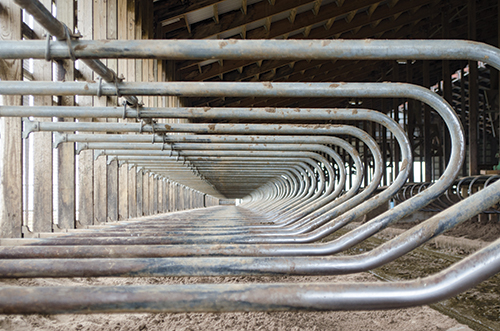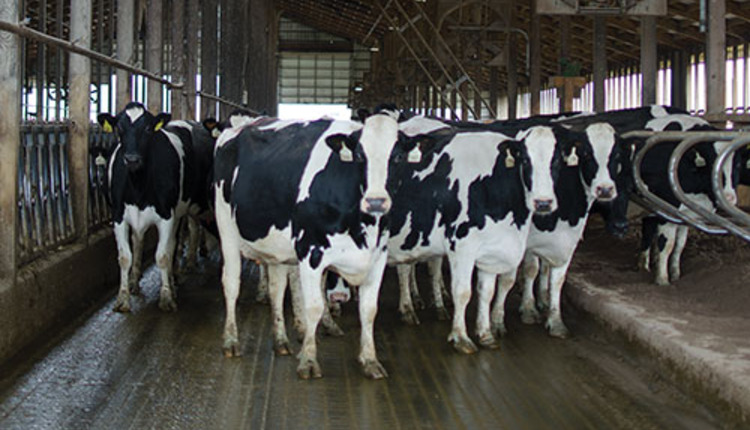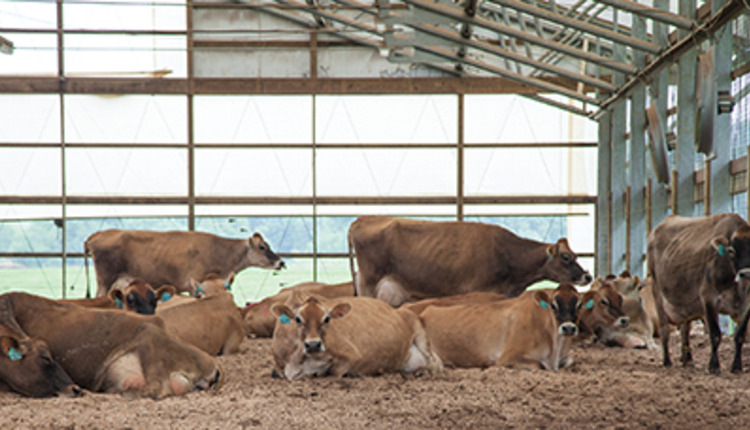The authors are a veterinarian who helped design Fair Oaks Dairy and Central Sands, and a professor of biological systems engineering at the University of Wisconsin-Madison.

Research and field experience tell us that an important design principle is to provide more than adequate access to feed and resting space for transition cows. Extra feed and resting space and wider traffic lanes all help provide optimal cow comfort and minimize the typical reduction in dry matter intake that occurs as cows go through the calving period.
On the flip side, inadequate feeding and resting space can result in metabolic problems, injuries and stress that keep the cows from entering the milking herd at the appropriate time and in the best condition possible. To help achieve the best transition cow health possible, here are nine crucial design considerations for transition cows.
1. Freestall space. Dimensions depend on size and breed of the cow. In general, freestall dimensions are larger because late-gestating cows are larger, heavy with calf and less mobile. The freestall platform should be easily accessible from walk alleys. A deep-bed sand base is an excellent bedding choice for the transition cows, providing a clean, dry resting surface with good footing to ease the rising and lying motions.
2. Group bedded pen space. The bedded resting area should be a minimum of 100 square feet (sq. ft.) per cow with 120 to 150 square feet recommended. This resting space does not include the alley space for accessing feed and water. Adequate space in a bedded pen and plenty of bedding can enhance the comfort and cleanliness of the cow without the necessity of intensive and frequent grooming and cleaning of the pen.
3. Individual bedded pen space. Individual calving pen space should provide 150 sq. ft. per cow of resting space. The base of the pen may be concrete, clay or sand. Although concrete floors are more easily cleaned, they may not provide the best footing surface. Clay, dirt or sand bases provide better footing and allow relatively easy cleaning of the pen when accessed by a skid steer.
At least 6 inches of long straw should be placed on top of the base. Bedding and manure accumulation should be removed and replaced with fresh dry bedding after every calving.
4. Feed space. Pen design should not create any additional limitations on feed intake. Current recommendations are that transition cows should have access to 30 inches of bunk space with headlocks spaced at 30 inches or with 24 inches between headlocks stocked to only 80 to 85 percent of the feeding space capacity.
Headlocks allow restraint for management purposes and do not restrict dry matter intake. Post and rail feeding fences can artificially reduce the feed space for submissive cows when a dominant cow commands more of the usable bunk space than she needs. Cows also try to stand diagonally to the feed line rather than perpendicular to the feed line, taking up more space than they need.
5. Walking space. Alley widths should be dimensioned to provide unrestricted access to the resting space. The distance between freestall rows should be a minimum of 10 feet, with 12 feet recommended, while the area between a freestall row and the feed line should be a minimum of 14 feet.
Crossover widths should be a minimum of 12 feet plus the space for a water location. Crossovers in a pen should be located approximately every 120 to 160 feet to provide easy access to feed and stalls. Additional crossovers create easy access to the feedbunk and provide another location for a waterer.
Strategically located double wide (32 feet) crossovers with a waterer splitting the crossover in a pen allows the opportunity to provide a flexible pen size between adjacent pens. Double wide crossovers with a waterer located in the center allow the pen to be resized by adding gates at the waterer.
6. Water space and location. The waterer should be sized to provide 3 inches of perimeter linear space per cow in the pen. There should be at least two water locations in each pen. Waterers are typically located at all crossovers of a freestall pen arrangement. Additional water locations can be placed on the outside wall alley during the summer.
In a bedded pen arrangement, the waterer is located between the feed access alley and the bedded resting space. A fence should prevent access to the waterer from the bedded resting space and only allow access from the alley side. This keeps the bedded space clean and dry. Providing water locations that can be shared by adjacent pens can provide more than one water location in a pen.
7. Freestall pen designs. Close-up and fresh cows can be housed in freestalls up to the point of calving. A two-row freestall pen design is an efficient pen layout providing the recommended feed space per cow and a freestall platform resting space for every cow in the pen without wasting space. In a close-up pen, a head-to-tail freestall row arrangement allows easy observation of the rear of animals as the manager walks up the feed lane.
In a fresh cow pen, a head-to-head arrangement is less costly to build with four curbs rather than five curbs and one post per two stalls rather than one post per stall. Therefore, 50 percent of the cows can go to a stall to rest with minimal walking.
A tail-to-tail arrangement has the benefit of allowing management to keep cows standing at the bunk, if desired. The outside alley is moved away from the outside cold wall and has 100 percent of the cows traveling in the alley, which may help minimize frozen manure. Crossovers should be wider and consider having two waterers to improve water and feed access.
Freestall pen designs with three rows have limited feed space on a per-cow basis, which will not efficiently use the resting space of the pen. A three-row pen design for the far-off dry cow and older heifer groups can be used when feed space is adequate. When a three-row freestall pen is used for close-up and fresh cow pens, the pen should be stocked according to recommended feed space per cow and typically will have fewer cows in the pen than the number of freestalls in the pen.
8. Group bedded pen design. When designing a group bedded pen space, the footprint of a freestall pen space should be used to design the pen geometry. This allows for future conversion of the bedded pen space into a freestall pen space. The pen arrangement should allow for easy bedding addition and convenient bedding and manure removal with a skid steer or front end loader.
9. Individual bedded calving pen design. The pen arrangement should allow for easily moving a cow from an adjacent close-up group pen to the calving pen with one person. The pen also should allow easy access for cleaning and bedding between calving cows. The calving pen should include access to water and a headlock with gates positioned to allow funneling the cow into the headlock for treatment and milking after calving. A vacuum line can be placed above the pen to allow milking out colostrum in the pen before moving the cow. Calving cows typically need less than 12 hours in a maternity pen.
Click here to return to the Animal Care E-Sources
150510_336

Research and field experience tell us that an important design principle is to provide more than adequate access to feed and resting space for transition cows. Extra feed and resting space and wider traffic lanes all help provide optimal cow comfort and minimize the typical reduction in dry matter intake that occurs as cows go through the calving period.
On the flip side, inadequate feeding and resting space can result in metabolic problems, injuries and stress that keep the cows from entering the milking herd at the appropriate time and in the best condition possible. To help achieve the best transition cow health possible, here are nine crucial design considerations for transition cows.
1. Freestall space. Dimensions depend on size and breed of the cow. In general, freestall dimensions are larger because late-gestating cows are larger, heavy with calf and less mobile. The freestall platform should be easily accessible from walk alleys. A deep-bed sand base is an excellent bedding choice for the transition cows, providing a clean, dry resting surface with good footing to ease the rising and lying motions.
2. Group bedded pen space. The bedded resting area should be a minimum of 100 square feet (sq. ft.) per cow with 120 to 150 square feet recommended. This resting space does not include the alley space for accessing feed and water. Adequate space in a bedded pen and plenty of bedding can enhance the comfort and cleanliness of the cow without the necessity of intensive and frequent grooming and cleaning of the pen.
3. Individual bedded pen space. Individual calving pen space should provide 150 sq. ft. per cow of resting space. The base of the pen may be concrete, clay or sand. Although concrete floors are more easily cleaned, they may not provide the best footing surface. Clay, dirt or sand bases provide better footing and allow relatively easy cleaning of the pen when accessed by a skid steer.
At least 6 inches of long straw should be placed on top of the base. Bedding and manure accumulation should be removed and replaced with fresh dry bedding after every calving.
4. Feed space. Pen design should not create any additional limitations on feed intake. Current recommendations are that transition cows should have access to 30 inches of bunk space with headlocks spaced at 30 inches or with 24 inches between headlocks stocked to only 80 to 85 percent of the feeding space capacity.
Headlocks allow restraint for management purposes and do not restrict dry matter intake. Post and rail feeding fences can artificially reduce the feed space for submissive cows when a dominant cow commands more of the usable bunk space than she needs. Cows also try to stand diagonally to the feed line rather than perpendicular to the feed line, taking up more space than they need.
5. Walking space. Alley widths should be dimensioned to provide unrestricted access to the resting space. The distance between freestall rows should be a minimum of 10 feet, with 12 feet recommended, while the area between a freestall row and the feed line should be a minimum of 14 feet.
Crossover widths should be a minimum of 12 feet plus the space for a water location. Crossovers in a pen should be located approximately every 120 to 160 feet to provide easy access to feed and stalls. Additional crossovers create easy access to the feedbunk and provide another location for a waterer.
Strategically located double wide (32 feet) crossovers with a waterer splitting the crossover in a pen allows the opportunity to provide a flexible pen size between adjacent pens. Double wide crossovers with a waterer located in the center allow the pen to be resized by adding gates at the waterer.
6. Water space and location. The waterer should be sized to provide 3 inches of perimeter linear space per cow in the pen. There should be at least two water locations in each pen. Waterers are typically located at all crossovers of a freestall pen arrangement. Additional water locations can be placed on the outside wall alley during the summer.
In a bedded pen arrangement, the waterer is located between the feed access alley and the bedded resting space. A fence should prevent access to the waterer from the bedded resting space and only allow access from the alley side. This keeps the bedded space clean and dry. Providing water locations that can be shared by adjacent pens can provide more than one water location in a pen.
7. Freestall pen designs. Close-up and fresh cows can be housed in freestalls up to the point of calving. A two-row freestall pen design is an efficient pen layout providing the recommended feed space per cow and a freestall platform resting space for every cow in the pen without wasting space. In a close-up pen, a head-to-tail freestall row arrangement allows easy observation of the rear of animals as the manager walks up the feed lane.
In a fresh cow pen, a head-to-head arrangement is less costly to build with four curbs rather than five curbs and one post per two stalls rather than one post per stall. Therefore, 50 percent of the cows can go to a stall to rest with minimal walking.
A tail-to-tail arrangement has the benefit of allowing management to keep cows standing at the bunk, if desired. The outside alley is moved away from the outside cold wall and has 100 percent of the cows traveling in the alley, which may help minimize frozen manure. Crossovers should be wider and consider having two waterers to improve water and feed access.
Freestall pen designs with three rows have limited feed space on a per-cow basis, which will not efficiently use the resting space of the pen. A three-row pen design for the far-off dry cow and older heifer groups can be used when feed space is adequate. When a three-row freestall pen is used for close-up and fresh cow pens, the pen should be stocked according to recommended feed space per cow and typically will have fewer cows in the pen than the number of freestalls in the pen.
8. Group bedded pen design. When designing a group bedded pen space, the footprint of a freestall pen space should be used to design the pen geometry. This allows for future conversion of the bedded pen space into a freestall pen space. The pen arrangement should allow for easy bedding addition and convenient bedding and manure removal with a skid steer or front end loader.
9. Individual bedded calving pen design. The pen arrangement should allow for easily moving a cow from an adjacent close-up group pen to the calving pen with one person. The pen also should allow easy access for cleaning and bedding between calving cows. The calving pen should include access to water and a headlock with gates positioned to allow funneling the cow into the headlock for treatment and milking after calving. A vacuum line can be placed above the pen to allow milking out colostrum in the pen before moving the cow. Calving cows typically need less than 12 hours in a maternity pen.
150510_336










